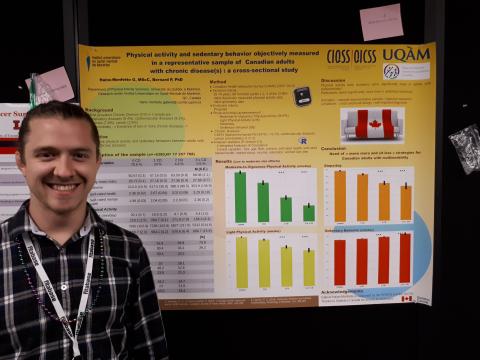Nouvelles des membres du Réseau Physical activity and sedentary behavior objectively measured in a representative sample of Canadian adults with chronic disease(s) : a cross-sectional study
Une affiche présentée par Gabriel Hains-Monfette, membre étudiant du RRSPQ, SBM's 39th Annual Meeting & Scientific Sessions, New Orleans, avec le support financier du RRSPQ. Monsieur Hains-Monfette est l'un des récipiendaires du dernier concours de soutien du RRSPQ à la participation à des conférences internationales. Félicitations!
Physical activity and sedentary measured objectively in a representative sample of adult with chronic disease : a cross-sectional study
Hains-Monfette, G.1,2, Bernard, P.1,2,
1 Université du Québec à Montréal, Montréal, Quebec, Canada
2 University Institute of Mental Health at Montreal, Montréal, Quebec, Canada
Objectives : (1) To compare objective physical activity and sedentary behaviors between canadian adults with and without chronic disease. (2) To examine physical activity and sedentary behaviors between adults with mutliple chronic disease.
Methods : Data were obtained from Canadian Health Mesure Survey (CHMS) (2007-2013) Physical activity and sedentary were measured using accelerometry in Canadians aged between 18 and 69 years. Data are presented as daily mean time spent in moderate and vigorous intensity physical activity (MVPA), light physical activity (LPA), sedentary, as well as steps accumulated per day. Pregnant women, participants with functional limitation were not included. Four self-reported chronic diseases were available (i.e., fibromyalgy, diabetes, heart diseases, cancer) in CHMS. The chronic obstructive pulmonary disease was determined with sprirometry measures. Among 8380 participants, those with 1, 2, 3 or more were compared with participants without chronic disease. A weighted ANCOVA regression model incorporating age, sex, body mass index, accelerometer wearing time, marital status, smoking status, education level and income was carried out.
Results : Distribution across healthy participants (74,82%), those with one chronic disease, two chronic diseases and three or more were 20,94%, 3,79% and 0,45%. Participants with two or three and more chronic diseases spent significantly less time in MVPA (m=11,58,se=1,56,p=0,0007)(m=7,43, se=1,6, p=0,0002) and LPA (m=182,74,se=7,2,p=0,0294)(m=160,87, se=14,48, p=0,0027) and had lower daily steps (m=6272,8,se=308,57,p=0,0292)(m=5339,02, se=542,4, p=4,86E-06) count compared with healthy adults (m=22,79,se=0,59)(m=216,09,se=1,79)(m=7972,79,se=82,1) or with one chronic disease (m=17,61,se=0,88)(m=210,53,se=3,36)(m=7598,05,se=163,62). However, sedentary time did not differ between the groups, ranging from (m=442,24,se=3,98) to (m=486,81, se=34,64).
Conclusion : Our findings highlight the importance of targeting interventions promoting physical activity towards adults with multiple chronic diseases. We found no evidence that adults with one chronic disease were more inactive in comparison to healthy adults.


